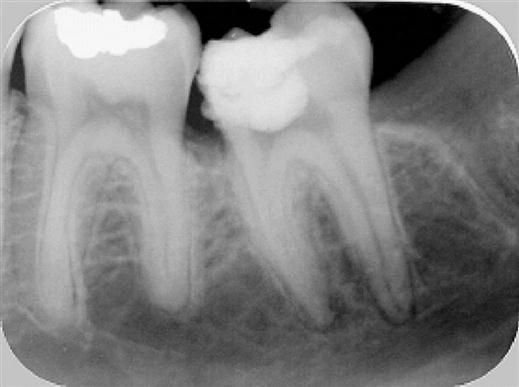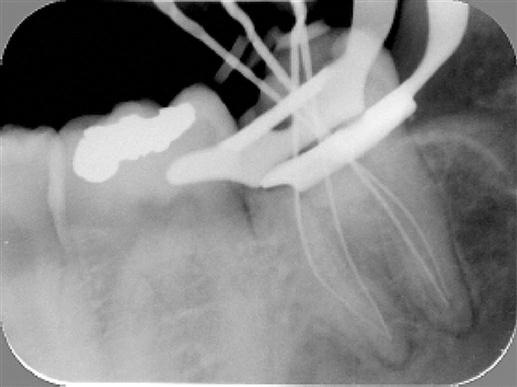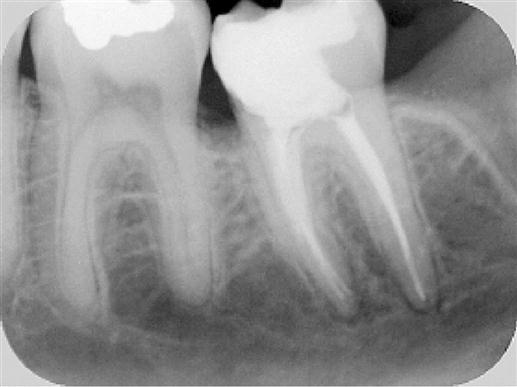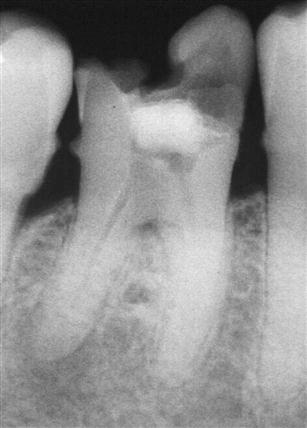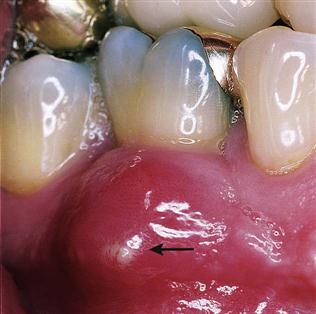Endodontics
Learning Objectives
1 Pronounce, define, and spell the Key Terms.
2 Describe the subjective and objective portions of the endodontic diagnosis.
3 Describe the role of radiographs in endodontics.
4 Describe the types of pulp therapy available.
5 Identify the specialized instruments used in endodontic treatment.
6 List the procedures of pulp therapy.
7 Discuss the dental assistant’s role in an endodontic procedure.
Key Terms
Control Tooth
Debridement
Direct Pulp Cap
Endodontist
Gutta-Percha
Indirect Pulp Cap
Irreversible Pulpitis
Necrotic
Nonvital
Obturation
Pulpectomy
Pulpotomy
Reversible Pulpitis
Sealer
Endodontics is a specialty in dentistry involved in the prevention, diagnosis, and treatment of diseases of the dental pulp. Endodontic treatment, which is often referred to as root canal therapy, provides an effective means of saving a tooth that might otherwise require extraction.
The general dentist is trained to care for simple endodontic cases; however, most dentists will refer a patient in need of pulp therapy to an endodontist, who specializes in this area of dentistry. Endodontic treatment does not include the placement of a final restoration following root canal therapy. Once endodontic treatment has been completed, the patient returns to his general dentist for placement of a permanent fixed restoration.
Endodontic Diagnosis
The endodontic diagnosis is made through an examination that has both subjective and objective components.
The subjective portion of the examination includes evaluation of symptoms or problems described by the patient. These include the patient’s description of the location, intensity, and duration of the pain. Specific questions to ask a patient include:
The objective examination includes the patient’s medical and dental histories, radiographs, clinical examination, and pulp vitality tests. Table 25-1 describes the types of tests completed to determine a tooth’s vitality.
TABLE 25-1
Diagnostic Testing of Vital Teeth
| Diagnostic Test | Description |
| Percussion test | Tapping on the incisal or occlusal surface with a mouth mirror handle provides the dentist with the ability to determine whether the inflammation process has extended into the periapical tissue. |
| Palpation test | The dentist applies firm pressure to the mucosa above the apex of the root. This helps the dentist determine whether the inflammation process has extended into the periapical tissue. |
| Cold test | Ice, dry ice, or ethyl chloride is used to determine the pulp response to cold temperature. |
| Heat test | A small piece of heated gutta-percha or the end of an instrument is heated and placed on the occlusal or incisal surface of the tooth to determine the pulp response. |
| Electric pulp testing | Delivers a small electrical stimulus to the pulp. A small quantity of toothpaste is used to establish an adequate contact to conduct the current from the pulp tester to the tooth. |
See Procedure 25-1: Assisting in Electric Pulp Vitality Test.
Control Tooth
A control tooth is used during each type of pulp testing procedure. This provides the dentist with a comparison of a healthy tooth with an infected tooth in terms of level of sensitivity.
A healthy tooth (of the same type) in the opposite quadrant is selected as a control tooth. For example, if the maxillary right first premolar (tooth #5) were the suspected tooth, the control tooth would then be the maxillary left first premolar (tooth #12).
The medical history may provide information about conditions that could contribute to the pain the patient is experiencing. An example is a patient with severe allergies may be experiencing unexplained dental pain in the maxillary anterior region.
The dental history may provide information concerning injury to a tooth or recent dental treatment that might help explain the pain the patient is experiencing.
Use of Radiographic Imaging in Endodontics
Radiographic images are a necessity in endodontics. The endodontist will request a periapical image to expose the full length of the tooth and the periapical tissue immediately surrounding the tooth in question.
A minimum of four images are exposed throughout an endodontic procedure. The following describe when a radiograph is required and at what stage of treatment:
1 Initial radiographic image: A periapical image of the tooth in question is exposed. This is completed at the diagnostic stage (Figure 25-1).
3 Final instrumentation radiograph: A periapical image of the tooth is taken with the final size of the file in all canals involved (Figure 25-2).
4 Root canal completion radiograph: A final periapical image is exposed of the completed canal that has been filled and temporized with an intermediate restorative material (Figure 25-3).
Diagnostic Conclusions
Once the subjective and objective tests have been completed, a diagnosis is presented to the patient.
Normal pulp indicates no subjective symptoms or objective signs. The tooth responded normally to sensory stimuli, and a healthy layer of dentin surrounds the pulp. Necrosis, also referred to as necrotic or nonvital, is determined if the tooth does not respond to sensory stimulus.
Pulpitis indicates that pulpal tissues have become inflamed. Pulpitis can be described clinically as follows: Reversible pulpitis occurs when the pulp is irritated from decay or moisture, and the patient is experiencing pain to thermal stimuli. By eliminating the irritant and placing a sedative material, the pulp may be saved. Irreversible pulpitis shows symptoms of lingering pain. Clinical diagnostic findings show that the pulp is incapable of healing, which would indicate the need for root canal therapy or extraction (Figure 25-4).
Periradicular abscess is an inflammatory reaction to pulpal infection (Figure 25-5). The lesion can be chronic, which would be asymptomatic with little or no discomfort, or acute, which would be associated with pain, tenderness, pus formation, and swelling.
Periodontal abscess is an inflammatory reaction caused by bacteria entrapped in the periodontal sulcus. Most often, a patient will experience rapid onset, pain, tenderness to pressure, pus formation, and swelling.
Periradicular cyst develops at or near the root of a necrotic tooth. This type of cyst occurs as an inflammatory response to pulpal infection and necrosis of the pulp.
Instruments in Endodontics
Endodontic instruments and accessories are designed to be flexible and to fit into the pulpal canal. To provide uniformity between manufacturers, the American Dental Association (ADA) has standardized the numbering and color-coded system used for files.
Files are supplied in different diameters, ranging from size 08 (the smallest) to size 140 (the largest). Files are available in various diameters and designs, based on their specific function. See Table 25-2 for photos and descriptions of the hand and rotary instruments most commonly used.
TABLE 25-2
Instruments and Armamentarium Used for Endodontic Procedures
< ?comst?>
| Name | Description |
Endodontic explorer
 |
A double-ended instrument with the working ends at an angle. The working end is long enough to enter and locate canal openings. |
Endodontic spoon excavator
 |
A double-ended instrument similar to other spoon excavators except that the shank is long, allowing the instrument to reach into the tooth and canal. |
Endodontic K-type file
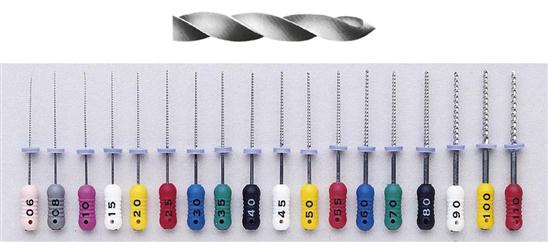 |
This file has a twisted design and is used in the initial debridement (cleaning) of the canal and in the later stages of shaping and contouring the canal. |
Hedstrom file
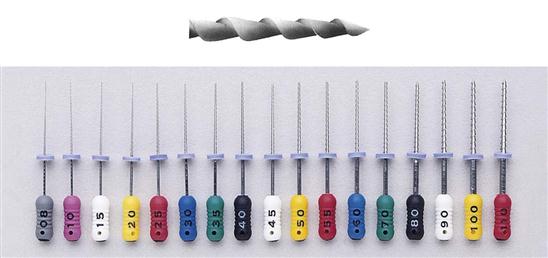 |
This file provides greater cutting efficiency because of the design. The Hedstrom file is used for final enlargement of the canal. |
Reamer file
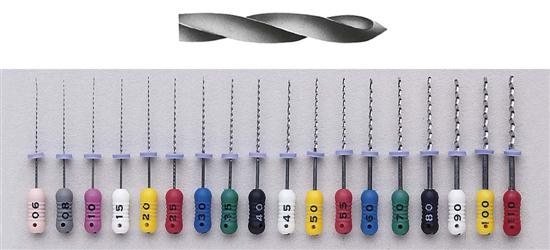 |
This file is similar in design to the K-type file, but with cutting edges farther apart. Its functions are to remove dentin structure and to smooth and increase the size of the canal. |
Broaches
 |
Broaches, which have tiny fishhook-like barbs along the shaft, are used to remove the bulk of the pulp tissue. They are also useful for removing fragments of paper points that become lodged in the canal. They are not used to shape or enlarge the canal. |
Gates-Glidden bur
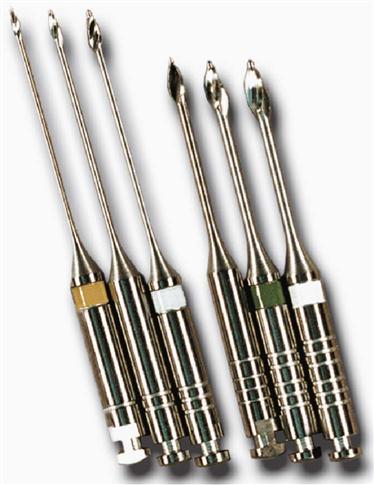 |
A football-shaped bur used on a low-speed handpiece. The bur has a very long shank with a latch-type attachment that is operated in a clockwise direction. These burs are not end-cutting. This means the cutting edge is only on the sides of the bur. |
Pesso file
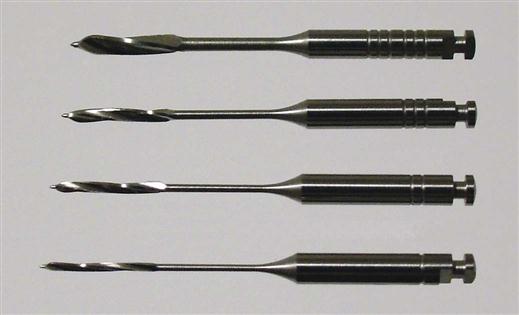 |
A Pesso file is used primarily when the tooth requires a parallel post preparation for placement of the final restoration. This file is adapted to the low-speed handpiece. |
Lentulo spiral
 |
The Lentulo spiral is a twisted wire instrument /> |
Stay updated, free dental videos. Join our Telegram channel

VIDEdental - Online dental courses


